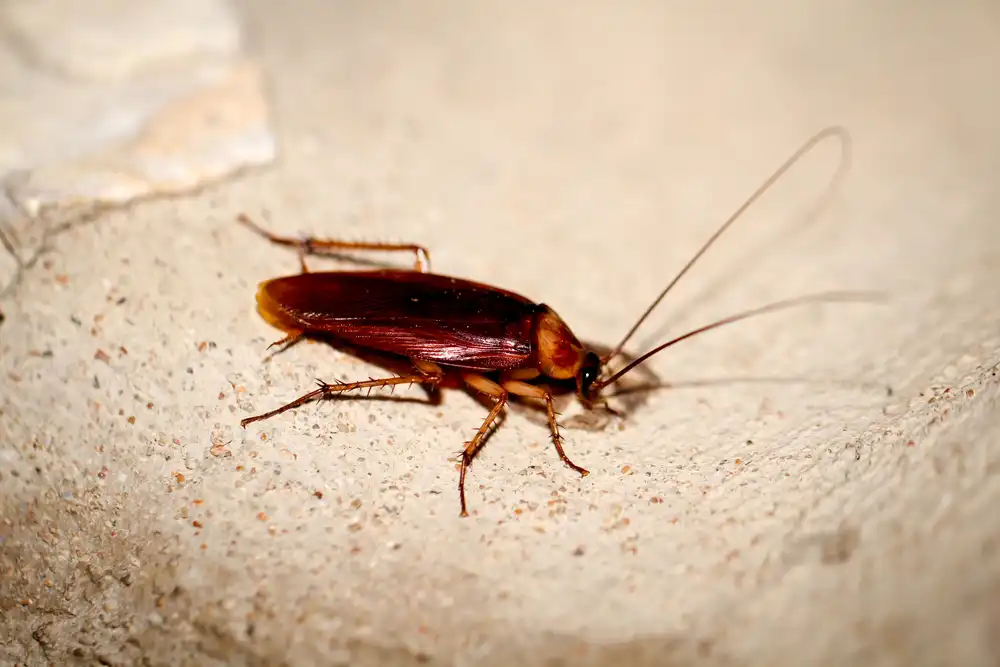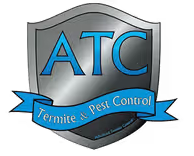Cockroach Identification & Prevention
What You Need To Know About Cockroaches In Baltimore, Maryland
We have put together a comprehensive pest guide to help you learn information about one of our region’s most common household pests – the cockroach. Cockroaches can be a nightmare for homeowners to deal with. They enter unnoticed, multiply quickly, and are challenging to eliminate. Keep reading to gain knowledge about the different types of cockroaches that call Baltimore, Maryland, home. While we don’t want to share our homes with cockroaches, cockroaches love to share our homes!

Frequently Asked Questions About Cockroaches
What are cockroaches?
Cockroaches are insects that we identify by their oval, flat body and long antenna. They are ancient insects that can adapt to living almost anywhere and, unfortunately for us, thrive inside our homes.
The four most common species of cockroaches to invade homes throughout Baltimore are American cockroaches, brown-banded cockroaches, German cockroaches, and oriental cockroaches. These cockroaches range in appearance. They can be brown, reddish-brown, tan, or black and vary in size from small at a half inch in length to a massive two inches in length. Some can fly, but most cockroaches prefer to use their six spiny legs to scurry from place to place. What every cockroach species has in common is that they don’t belong inside our homes.
Are they’re different types of cockroaches?
Yes, the common types of roaches are:
German Cockroach – Light brown overall in color, has wings which cover the abdomen, and an adult is about 5/8 inch long. The shield just behind the head is marked with two prominent black stripes. Females produce an egg capsule that is attached to the end of the abdomen for up to a month before being dropped a day or so before eggs hatch. Each 5/16 inch long, brown egg capsule contains 30 to 40 eggs which hatch in 2 to 4 days after being deposited. Nymphs hatching from eggs are less than 1/8 inch long and wingless. They develop through 6 to 7 stages (instars) over 74 to 85 days (varying with temperature) before becoming adults. There may be four generations per year. German roaches are mainly an indoor species although they will also migrate outdoors from structure to structure. Occasionally, new infestations begin by bringing in cartons and other materials from infested structures that harbor the roaches or their eggs. Kitchens, bathrooms and other locations that provide food, moisture, warmth and shelter are preferred habitats. German cockroaches are mainly active at night, when they search for food and water. During the day, they remain concealed in cracks and crevices unless they are over-crowded, with all developmental stages occurring together. They also can occur in attics, wall voids, crawl spaces, foundation cracks, garbage areas and around the landscape. ATC also has do it yourself kits!
Oriental Cockroach – Known also as a waterbug or black beetle. It can be found in all parts of the United States. The length of the oriental cockroach is about 1 1/4 inch for the female and about 1 inch for the male. Both have wings but cannot fly. The adults are dark brown and nearly black. The egg capsule is carried by the female for about 30 hours where it is either dropped are attached to a protected surface near a food source. The females will produce an average of 8 capsules containing about 16 to 20 eggs each and will hatch in about 60 days. Nymphs will molt 7 to 10 times and the stages usually take several months to a year to complete. The oriental cockroach can be found in high moisture areas such as sewers and damp basements. They are usually located below ground level indoors. You probably won’t find them on walls or high in cupboards or on the upper floors of buildings. Oriental cockroaches feed on all kinds of filth and other decaying organic matter. They can live for about a month without food but only about 2 weeks without water. In cold weather you will probably find them migrating indoors. ATC also has do it yourself kits!
American Cockroach – The largest species of common cockroach, growing to an average length of around 4 centimeters (1.6 in) and about 7 millimeters (0.28 in) tall. They are reddish brown and have a yellowish margin on the body region behind the head. Immature cockroaches resemble adults except that they are wingless. These insects are very active at night and travel very quickly, often darting out of sight when someone enters a room. They can fit into small cracks and under doors despite their fairly large size and are considered one of the fastest running insects. American cockroaches generally live in warm, moist areas, preferring warm temperatures of about 84 °F but they can survive in dry areas if they have access to water. They and do not tolerate cold temperatures. These cockroaches are common in basements, crawl spaces, cracks and crevices of porches, foundations, and walkways adjacent to buildings and feed on decaying organic matter and a variety of other foods.
Females lay eggs and the immature cockroaches emerge from their egg cases in 6 to 8 weeks and require 6 to 12 months to mature. Adult cockroaches can live up to one year, during which females produce an average of 150 young. ATC also has do it yourself kits!
Brown-Banded Cockroach – A small species of cockroach, measuring about ? in (10 to 14mm) long. It is tan to light brown and has two light-colored bands across the wings andabdomen. The male has more slender wings that cover the abdomen, while the female’s wider wings do not cover the abdomen completely. They need less moisture than the German cockroach so they tend to be more broadly distributed in the home, such as in living rooms and bedrooms. They are less common in restaurants and tend not to be found in the daytime, since they avoid light. The brown-banded cockroach eats a wide variety of items. Cockroaches are usuallyscavengers, and thus can eat a wide array of items, often almost anything organic, including decaying matter. It has been known to cause problems in hospitals by emerging at night to feed on bodily fluids, thereby risking cross-infection. ATC also has do it yourself kits!
Are cockroaches dangerous?
Cockroaches are dangerous, and keeping them out of your house is vital to your family’s health. Cockroaches feed on rotting materials and live in unsanitary places that put them in constant contact with bacteria, human pathogens, and parasites. When cockroaches get into your home, they will spread the pathogens they carry to surfaces and food and can make you and your family ill.
Additionally, cockroaches produce many allergens into the air that can trigger allergies and asthma attacks. Living with cockroaches for long periods can significantly impact your health and ability to feel at home inside your house.
Why do I have a cockroach problem?
Cockroaches are scavengers and will eat almost anything they come across. Greasy food, sweets, and starches are their favorite foods, but if they can’t find them, they have no problem eating toothpaste, hair, or even paper. Their ability to eat almost anything is why every home, no matter how clean, is at risk for a cockroach infestation.
Cockroaches find their way into our homes on their own as they search for areas of moisture and food. They move inside through cracks and other openings they come across in its exterior. Cockroaches also get into our homes by hitchhiking. After crawling into boxes, deliveries, appliances, and secondhand items, they are introduced into new structures.
Where will I find cockroaches?
When cockroaches enter our homes, they hide in tight cracks and crevices. Cockroaches like the feeling of a solid surface on both the front and back of their body. Hiding in tight spaces and being nocturnal means it can take some time for homeowners to discover the presence of cockroaches in their houses.
American, German, and oriental cockroaches prefer to live in warm, humid areas like kitchens, bathrooms, and utility rooms. The brown-banded cockroach prefers warm, dry areas like attics and closets.
Some of the most common spots to find cockroaches hiding throughout a home include behind appliances, sinks, cabinets, drawers, and loose wallpaper or backsplash. They also like to hang out in areas of clutter and under things like cardboard boxes and stacks of paper.
How do I get rid of cockroaches?
The cockroach is a common household pest that can find its way into any of our Baltimore homes. Implementing professional pest control services is the best way to eliminate unwanted cockroaches from your property and keep them and other pests away for good.
Here at ATC Pest Control, we offer the full-service home pest control services necessary to help you maintain a pest-free household. Cockroaches are no match for our dedicated professionals, high-quality treatments, and commitment to our customers. To learn more about cockroach control in Baltimore, call today.
How can I prevent cockroaches in the future?
Learn how to deter cockroaches and stop them from getting into and taking over your Baltimore home with the help of the following tips.
- Keep drains clean and place mesh cover over all drains and vents entering your home.
- Make sure weatherstripping and door sweeps are in place.
- Seal cracks that develop in your home’s foundation.
- Inspect boxes, secondhand items, and potted plants you bring into your home for hitchhiking cockroaches before bringing them inside.
- Reduce excess moisture in your home by using dehumidifiers and air-conditioners.
If cockroaches ever find their way into your home, don’t panic; reach out to the professionals at ATC Pest Control! For cockroach control near you, contact us today!
Eradicating Your Roach Problem
The ATC Annual Protection Program
This is our most effective and advanced program. This service protects you against ALL pests. While other company’s try to figure out ways to reduce your coverage, ATC just covers them all! Ants, mice, spiders, stink bugs, roaches, bees, wasps, wildlife, termites bed bug insurance and any other pest you can think of, are covered. The annual service takes on average, 2-hours and at any time during the year you have any issues you simply contact us and we come out and take care of it for free.
Schedule Your Inspection
Complete the form below to schedule your no obligation inspection



